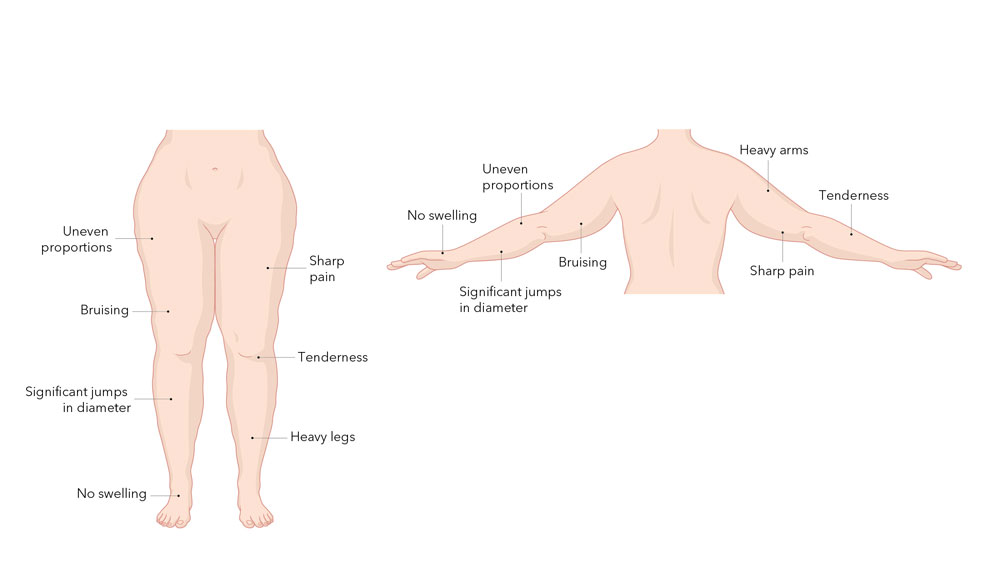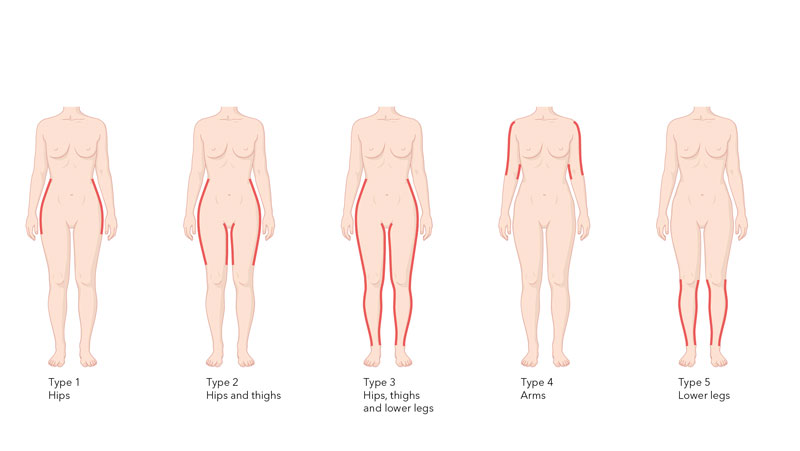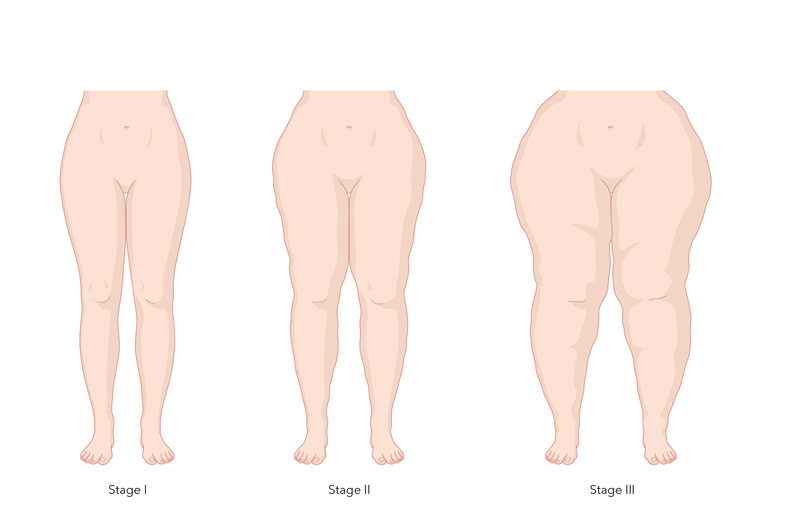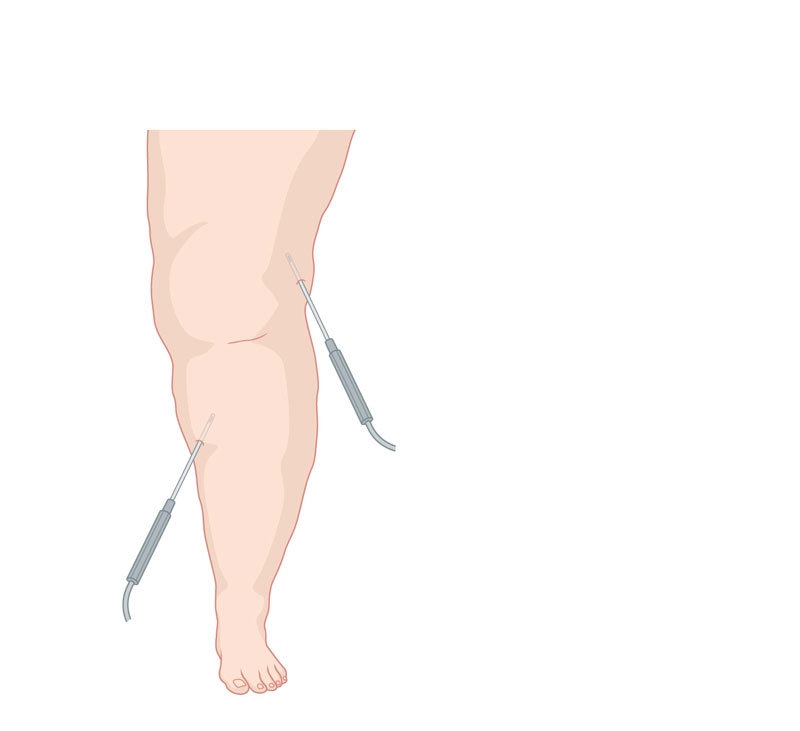Symptoms | Diagnosis | Causes | Conservative Treatments | Surgical Treatment | Consultation | FAQ
WHAT IS LIPOEDEMA?
Lipoedema is a chronic, progressive condition affecting fat distribution in which subcutaneous fatty tissue increases disproportionately in certain areas of your body.
The additional tissue presses on other structures such as the lymphatic vessels. The accumulated fluid then causes the limbs to swell even more.
The swelling and increased body proportions can be a major restriction in everyday life and place a heavy psychological burden on those affected.
Without targeted, early treatment of the lipoedema, lymphoedema can also develop over the long term, due to the lipoedema itself or congestion of lymphatic fluid.
WHICH PARTS OF THE BODY ARE AFFECTED?
The legs, hips and arms are most frequently affected.
Lipoedema can be ruled out in the chest and abdominal area. The feet and hands also remain unaffected in most cases.
As a result, there is a noticeable and visual difference in the proportions of the lower and upper body.
People affected by lipoedema most frequently experience the following symptoms (the severity can vary):
Physical symptoms
- Irregular tissue structure (bilateral symmetrical fat deposits) in the areas affected
- Spontaneous and/or dull pain that usually increases during the day and is made worse by sitting or standing for long periods of time
- Highly sensitive to touch in the body region affected
- Rapid bruising, e.g., after a minor impact, due to the very sensitive blood vessels in the tissue
- Lumps or nodules in the skin
Psychological symptoms
People with lipoedema usually also report psychological symptoms, which are often associated with the changes in their appearance.
As a result, psychological support is usually also recommended.
WHO IS MOST FREQUENTLY AFFECTED BY LIPOEDEMA?
Lipoedema is most commonly diagnosed in women.
However, lipoedema can also occur in men if they have liver disease or a hormone condition (e.g., testosterone deficiency) or are undergoing hormone treatment (e.g., for prostate cancer).
There is sometimes a family history of the condition. Parents and siblings of people affected have similar symptoms in 30 to 60% of cases. However, exact figures on the incidence are still lacking. There is also often a tendency to be overweight.
A physical examination can quickly determine whether the individual has lipoedema.
The earlier lipoedema is diagnosed, the more quickly any negative long-term health consequences can be prevented through individually tailored treatment.
It is also very important to rule out other causes in relation to the symptoms.
If lipoedema is diagnosed, the type and stage of the lipoedema are also assessed during the physical examination.
Types of lipoedema There are five types of lipoedema:
There are five types of lipoedema:
- Type 1: Hips
- Type 2: Hips and thighs
- Type 3: Hips, thighs and lower legs
- Type 4: Arms
- Type 5: Lower legs
What are the stages of lipoedema? There are three stages of lipoedema development:
There are three stages of lipoedema development:
- Stage 1: smooth skin, small lumps or nodules, soft subcutaneous fatty tissue, slight bulging
- Stage 2: uneven skin structure, subcutaneous fatty tissue has nodules and bulges or lobes
- Stage 3: large skin folds, large nodules or lobules in the subcutaneous fatty tissue, severe changes to the contour of the legs, fat bulges
Important: The symptoms can already be very advanced in stage 1. At the same time, some individuals in stage 3 report only very slight pain. The symptoms (especially pain) and the stage do not necessarily run in parallel.
Research into the exact causes is still in progress. However, experience has shown that the following factors can cause or worsen lipoedema:
Hormonal changes and genetic predisposition
Hormonal influences are strongly suspected, as the onset of the condition often occurs during phases of hormonal change such as puberty, pregnancy or menopause.
Diet and exercise
The most common causes include poor diet quality and a lack of exercise over a long period of time.
As a consequence, body weight increases, fat cells enlarge and the fatty tissue is no longer supplied with sufficient oxygen (as the fat cells form faster than the required blood vessels). This undesirable process can trigger inflammation, which causes pain.
Chronic stress, anxiety and depression
Anxiety, depression and chronic stress can fuel the pain via inflammatory mediators in the skin.
It is important to differentiate between acute and chronic pain and take mental health into account within the treatment process.
WHAT IS KNOWN ABOUT THE COURSE OF LIPOEDEMA?
The course of the condition is influenced by many factors and therefore varies greatly.
For a long time, it was assumed that the condition steadily worsened. Now, however, it is clear that this does not have to be the case – as long as lipoedema is treated early and medically correctly.
The course of the disease can be positively influenced by ongoing weight control. Experience has shown that long-term professional nutritional advice or support is very valuable for this purpose.
IS THERE A CONNECTION BETWEEN LIPOEDEMA, OBESITY/SEVERE OVERWEIGHT AND LYMPHOEDEMA?
Yes, weight gain or obesity exacerbates the symptoms associated with lipoedema. Maintaining a healthy, stable weight and getting regular exercise are therefore essential for people affected.
Being very overweight can cause lymphoedema to develop. This causes swelling in the affected area of the body due to the lymph (lymphatic fluid) that can no longer be drained.
The progression of lymphoedema is usually not linear but causes increased symptoms over time, such as tissue hardening. As a result, the local immune defence is also weakened, which increases the risk of inflammation locally.
Many people suffer from three conditions at the same time: Lipoedema, obesity and lymphoedema. All three conditions must be treated.
WHAT IS THE AIM OF THE TREATMENT?
As lipoedema cannot be cured, the aims of treatment are as follows:
- Control/contain the growth of lipoedema
- Improve the functionality of the body regions affected
- Prevent complications
- Provide assistance with mental health and nutrition
WHAT DOES THE FIRST MEDICAL CONSULTATION INVOLVE?
We will meet personally and address the following key questions:
- What (physical and psychological) symptoms are causing the most problems?
- What should the treatment improve?
A thorough physical examination is also carried out, which includes the following:
- Determining the volume of the body regions affected
- Measuring body weight and the ratio of waist circumference to height
- Assessing pain intensity, activity level, fatigue, quality of life and stress
- Addressing obesity
HOW IS LIPOEDEMA TREATED BY OUR SPECIALISTS?
Our treatment programme covers the following areas:
- Compression therapy
- Physiotherapy/movement therapy
- Liposuction
- Weight management
- Psychosocial therapy
- Self management
Manual lymphatic drainage
If there is severe pain, a form of physiotherapy known as manual lymphatic drainage can be an effective treatment to start with. The gentle pressure applied during treatment can relieve the acute pain so that continual compression can be used successfully following the treatment.
Compression therapy is very important. This is provided using modern compression bandages.
The intervals between treatments are continually extended over time.
Towards the end of the intensive phase, the areas of the body affected are measured and the orthopaedic technicians produce custom-made compression stockings.
The intensive phase is followed by the maintenance phase, during which people affected wear compression stockings and take part in an exercise programme.
The continual use of compression stockings in combination with regular physical exercise and controlling and maintaining body weight are key factors in conservative treatment.
Physiotherapy and psychosocial therapy
A referral is made to a physiotherapist and the option of talking to a specialist about the psychological effects of the disease is also offered.
We issue medical prescriptions for both forms of therapy.
Medication
Medication is not used to treat lipoedema. Conservative therapy focuses on compression therapy in combination with targeted physiotherapy.
If comprehensive conservative therapy has been carried out for at least six months and the symptoms have not been satisfactorily reduced, surgical treatment can be considered.
Liposuction
 Thanks to our state-of-the-art infrastructure and many years of experience, we can remove large volumes of fat without the need for a major incision and without damaging the tissue.
Thanks to our state-of-the-art infrastructure and many years of experience, we can remove large volumes of fat without the need for a major incision and without damaging the tissue.
Lipoedema is treated using water-jet-assisted liposuction, which differs from purely aesthetic treatments.
Simply put, the fat cells are flushed out, while the blood vessels and lymphatic vessels are retained. Another advantage of this procedure is the faster recovery after the operation.
Even though large amounts of fatty tissue can be removed in a single procedure, several procedures are usually necessary. As a result, an individual treatment plan and personalised support are very important.
WHAT FOLLOW-UP TREATMENT IS REQUIRED (SELF MANAGEMENT AND WEIGHT MANAGEMENT)?
After the procedure, it is still necessary to ensure that the person’s weight remains stable (through nutrition and exercise) and that support/compression stockings are used as needed, as this chronic fat distribution disorder cannot be eliminated through liposuction.
It may also be necessary to continue physiotherapy in many cases. Increasing muscle strength and endurance can have a positive effect on inflammatory processes in the tissue.
Technically challenging procedures such as lipoedema treatment should always be carried out by experienced specialists. This enables the complication rate to be reduced to an absolute minimum.
Our specialist in lipoedema treatments, Professor Mario Scaglioni, has many years of experience and a high level of expertise in lymphatic surgery.
They are a well-coordinated team that will take care of you and your health comprehensively, expertly and personally. Contact us online or by phone to arrange your individual appointment.
Which types of exercise/sports are suitable for people with lipoedema?
Sports that are easy on the joints or do not put too much stress on them are particularly recommended: Swimming, gentle cycling, yoga and fast walking. If you are affected by lipoedema, regular exercise is extremely important.
What kind of clothing is recommended?
Wearing compression stockings is important to relieve the pressure on the tissue and alleviate any pain.
Tight-fitting clothing should be avoided to prevent unnecessary pain and swelling.
What should I eat and drink?
In general, it is important to eat a healthy and balanced diet that can be integrated into everyday life for the long term.
The following nutritional recommendations are key:
- Drink enough water (no sweet drinks)
- Eat a healthy amount of carbohydrates (as few simple sugars as possible)
- Eat a high-fibre diet (lots of vegetables and unprocessed foods)
- Focus on unsaturated, healthier fats
Individual nutritional advice is highly recommended.